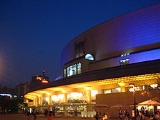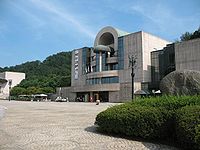
Seoul Arts Center
Encyclopedia
The Seoul Arts Center, literally the Hall of Arts, is a cultural center in Seocho-gu
, the southern area of Seoul
, South Korea
.
Measuring in 12,0350 m², it consists of many different halls and centers for many diverse art forms. It began construction in 1984, and opened all its doors in 1993. It was started by the notion to bring a more solid aspect to the Korean arts and cultural scene, and to bring the Korean arts to an international level. It consists of the main Festival Hall, Calligraphy Hall, Music Hall, Arts Center, Center of Archives, Education Hall which are all housed indoors, and the Circular Plaza, Street of Meetings, Traditional Korean Gardens, an outdoor Theater, and a market place.
The central venue, which is the Opera House, was built basing designs on the traditional hat for Korean men, the "gat", worn during the Joseon Dynasty
by grown men who had passed the gwageo
. The Music Hall was designed with the idea of a Korean fan in mind.
 Completed in 1988, the world's only exhibition center for works of calligraphy, together with the National Traditional Music Conservatory, Outside Playgrounds and Korean Gardens, it creates an authentic traditional Korean atmosphere to the Center.
Completed in 1988, the world's only exhibition center for works of calligraphy, together with the National Traditional Music Conservatory, Outside Playgrounds and Korean Gardens, it creates an authentic traditional Korean atmosphere to the Center.
The Culture Plazas
Resident Companies
There are also under "Dongbaek" and many individual contributors and donors, including the Samsung
Chairman, Lee Gun Hee.
Seocho-gu
Seocho-gu is a gu of Seoul, South Korea. It is a popular residential area for the mid- or upper-class residents in Seoul and home to the Supreme Court and the Supreme Prosecutors' Office. Seocho Samsung Town in Seocho-dong, near Gangnam Station, is the headquarter of the several corporations of the...
, the southern area of Seoul
Seoul
Seoul , officially the Seoul Special City, is the capital and largest metropolis of South Korea. A megacity with a population of over 10 million, it is the largest city proper in the OECD developed world...
, South Korea
South Korea
The Republic of Korea , , is a sovereign state in East Asia, located on the southern portion of the Korean Peninsula. It is neighbored by the People's Republic of China to the west, Japan to the east, North Korea to the north, and the East China Sea and Republic of China to the south...
.
Measuring in 12,0350 m², it consists of many different halls and centers for many diverse art forms. It began construction in 1984, and opened all its doors in 1993. It was started by the notion to bring a more solid aspect to the Korean arts and cultural scene, and to bring the Korean arts to an international level. It consists of the main Festival Hall, Calligraphy Hall, Music Hall, Arts Center, Center of Archives, Education Hall which are all housed indoors, and the Circular Plaza, Street of Meetings, Traditional Korean Gardens, an outdoor Theater, and a market place.
The central venue, which is the Opera House, was built basing designs on the traditional hat for Korean men, the "gat", worn during the Joseon Dynasty
Joseon Dynasty
Joseon , was a Korean state founded by Taejo Yi Seong-gye that lasted for approximately five centuries. It was founded in the aftermath of the overthrow of the Goryeo at what is today the city of Kaesong. Early on, Korea was retitled and the capital was relocated to modern-day Seoul...
by grown men who had passed the gwageo
Gwageo
The gwageo were the national civil service examinations under the Goryeo and Joseon dynasties of Korea. Typically quite demanding, these tests measured candidates' knowledge of the Chinese classics, and sometimes also of technical subjects...
. The Music Hall was designed with the idea of a Korean fan in mind.
The Opera Theater
The Opera Theater is the main part to the central building that is the Opera House. It is the basis of operations for all ballet performances, Korean traditional creative plays, Modern dance and Musicals. There are 2340 seats, and houses 3 separate auxiliary stages that can prepare for the next act without a time constraint. There are two sections of the House curtains, 30 different semi-curtains, providing the best possible environment for the staff and performers. In the theater, it also maintains the Opera Practice Room, Ballet Rehearsal Room, Play Rehearsal Rooms with much generosity to the staff and crew who need adequate facilities to provide a good performance.Towol Theater
This theater was built for the purpose of staging original and traditional plays. Dance, musicals, operettas, and opera buffas are also given prominence. It maintains the proscenium stage, so that many different variations and traditional plays can be staged. It is often called the Mini Opera Theater, enabling much interaction and communication between the audience and the actors. Using three stages, it can easily take on from classical to modern plays, including small scale operas and musicals and creative music plays. It can seat 710 people.Freedom Minor Theater
The word freedom comes from the idea that the producer and choreographers of the play or performance can change the settings of the seatings, audience structure without conforming to the set design of the seating. It can vary between 300 to 600 seats, depending on the producer's will, it can change from an arena, to a proscenium, and an impactual non-conforming stage, its main characteristic is that it aims to destroy the barrier between the audience and the stage.Concert Hall
Already approved and accredited by the world's most famous musicians, the Concert Hall in the House of Music, or the Music House, is an authentic concert hall measuring in 9,569 m². After its opening in 1988, it has been loved most by the Korean artists, and has been the stage for invitational performances from artists overseas. It has no house curtain, enabling a complete interaction between the audience and the performer. It is able to seat 2600 people, spanning over three floors, maintains its box seats, and choir sections.Recital Hall
Housing 400 seats, it is the stage for solo performances, chamber music, and experimental creative music, concentrating on the delivery of music and acoustics rather than noise and sound. Many debuts are staged in the Recital Hall, being the forefront of many active new upcomings in the field of music. Built on the correct sound acoustics and perfect delivery of tune and notes rather than ambiance.Hangaram Art Gallery(한가람미술관)
Despite its confining name "museum" on its website, the Hangaram Art Museum is more close to a gallery complex of art work. Situated in the east wing of the Center, opened its door in 1990, it strives to be a museum with a more interactive environment. It concentrates on modern art and contemporary art enabling younger people to enjoy their visits. Measuring in 15,434 m², its first and second floors are connected so that major works of art can be displayed without difficulty. The museum uses natural lighting installed in many respectable European art museums to illuminate its art works.Visual Arts Archives
A place that does not falter with the communications age, it enables the active trade and information sharing both nationally and overseas. Many of its archives are accessible free of charge, on the first floor, the Designer's Club, ran by the Center itself, and the Design Art Museum together with the various Audio-Visual Archives and viewing rooms situated on the second floor run by the Korean Arts and Culture Development Commission are a great asset to the archives as a whole. With a price of 500 won ($0.50), one can view videos for one full day without restraints.Video Archives Hall, Audio Visual Archives Center, Audio-Visual Halls
The three other main centers play a similar role to the v.a. archives. The Video Archives Hall maintaining 35 mm film theater seating 160 people, and an 18 mm film theater for 80 odd people. Many rare collections of film are available to be viewed. The Audio Visual Archives house many different types of collections of visual art work.The Documents Archive
A room that seats 70 people, this archive houses periodicals, journals, theses, scenarios, posters, music sheets, pamphlets, photo materials that can be viewed without restrictions. There are many rare documents, including 6000 play dialogues and scripts.Hangaram Design Arts Center(한가람 디자인 미술관)
Divided into Gallery No.1, No. 2, Collection Gallery and the Semiar Room, it displays works of art with much creativity in terms of layout and general choreography of the displaying show. Not only restricted to art exhibitions, it can be a multi-purpose center for many different art related activities and works of art.Seoul Calligraphy Art Museum

The Outer Cloisters
Frequently visited by early morning joggers, many different places are open to average citizen in this diverse area outside the center.- Outer Amphitheater: Shaped similarly to a traditional flower pot, the Outer Amphitheater is a large theater.
- Umyunji: A small pond, for the traditional 'pansori' music,
The Culture Plazas
- Music Plaza: Staging films and musical performances
- Art Plaza: Sculptor Plaza and exhibitionist artworks are displayed.
- Staircase Plaza: A unique plaza in itself
- World Music Fountain: Situated between the Opera House and the House of Music, measuring 43 x 9 meters, it is the biggest fountain in the country. From spring to autumn, the fountains "dance" in tune to music from various countries of the world.
Cohabitants and Resident Companies
Cohabitants- Korea National Ballet CompanyKorea National Ballet CompanyThe Korea National Ballet Company is a South Korean ballet company. It was founded in 1962 as the National Ballet Company. It was one of the affiliates of the National Theater of Korea until 1999, when it separated to independently reestablish itself in the Seoul Arts Center in the following year...
- National Opera of Korea
- National Chorus of Korea
- The Korean Symphony Orchestra
Resident Companies
- Seoul Performing Arts Company
- Korean National University of Arts
- Archives Center of Korean Film
- National Center for the Korean Traditional Performing Arts
- Korean Arts and Culture Federation
- National Association of Cultural and Arts Centers
- Seoul Symphony Orchestra
The Patrons of the Seoul Arts Center
The financial backing is arranged by the following companies and individuals in Korea. They are arranged in different categories.Mugunghwa
- Daeil Constructions Co.
- Daegyo (Pty) Ltd.
- The Korean Tobacco and Ginseng Company, Ltd. 한국담배인삼공사
- Egun Industries Ltd.
- Korea Electric Power Corporation 한국전력공사
- Korea Gas Power Corporation 한국가스공사
Moran
- SK Telecommunications Ltd.
- GS Caltex Ltd.
- Euro Trading Ltd.
There are also under "Dongbaek" and many individual contributors and donors, including the Samsung
Samsung
The Samsung Group is a South Korean multinational conglomerate corporation headquartered in Samsung Town, Seoul, South Korea...
Chairman, Lee Gun Hee.
See also
- The National Center for Korean Traditional Performing ArtsThe National Center for Korean Traditional Performing ArtsNational Gugak Center, located in Seoul, South Korea, is the primary institution of learning for Korean traditional music.With a history dating back to the Eumseongseo music institute of the Silla kingdom in the 7th century, The National Center for Korean Traditional Performing Arts was founded...
- Contemporary culture of South KoreaContemporary culture of South KoreaThe contemporary culture of South Korea developed from the traditional culture of Korea, and on its own path away from North Korean culture since the division of Korea in 1948. The industrialization and urbanization of South Korea, especially Seoul, have brought many changes to the way Korean...
- List of concert halls
- List of Korea-related topics

